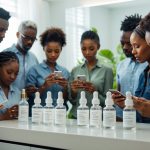Ingredient Lists on Serums Stylists Reveal Most Adults Read Wrong
The Wild West of Serum Trends
Nobody reads ingredient lists right. Niacinamide, glycerin—everywhere. But does anyone notice algae extract or PDRN? FDA changes the rules every year, and I’m stuck translating “natural” from buzzword to something real. Even I get tripped up by exosome serums and postbiotics—are they real or just hype?
“Natural” Ingredients: The Latest Hype
Exosomes and plant stem cells—everyone’s talking about them. Supposed to be “cleaner” and “greener,” but then there’s “fragrance” right in the middle. Tatcha, IOPE, whoever—front label says botanicals, back label says chemicals I can’t pronounce. Ecklonia cava extract? Sure, it’s algae, but nobody knows that unless you live on Reddit.
| Emerging “Natural” | What’s Supposed to Happen |
|---|---|
| Plant stem cells | “Rejuvenation” (antioxidants, really) |
| Exosomes | Cell signaling—maybe, maybe not |
| Algae extracts | Hydration/collagen? Maybe, if you use it forever |
| Postbiotics | Barrier support, but don’t expect miracles |
People want “natural.” Most of it’s just a dried fruit at the end of the list. Science? Meh.
Transparency—Good Luck With That
Why do people trust the front label? FDA “regulates” ingredient lists, but not really. “Fragrance” isn’t real disclosure. “Full transparency” and “green chemistry” mean nothing when the fine print is a mess. Brands still hide stuff behind “proprietary blend.”
Derms say marketing is way ahead of the rules. I see new “clinically tested” stickers every week—means nothing. NewBeauty says only 30% of adults can ID main actives. Most people just give up and buy whatever has a shiny label.
Will transparency ever be real? Doubt it. I try to explain INCI naming and people just zone out. Brands will probably list “glow factor” as an ingredient next year and nobody will blink.
Frequently Asked Questions
I’m still annoyed that bottles never make actives obvious. You’re expected to squint and Google half the words. Ingredient order matters, but I’ve seen “vitamin C serums” where ascorbic acid is in the last third—why even bother?
What should you even look for in a serum, anyway?
Hyaluronic acid isn’t magic. It’s in everything. If it’s not paired with niacinamide or peptides, I barely notice a difference. Dr. Shari Marchbein says (and I agree) the top four ingredients do the work—after that, it’s just filler.
People obsess over “retinol” or “vitamin C,” but check how far down the list they are. I’ve seen “ferulic acid” hyped on the box, but the serum is basically just dimethicone. Welcome to skincare.
How can you tell if a skincare ingredient is effective?
Honestly? I stare at these ingredient lists and just laugh. All the “powerful” stuff—niacinamide, licorice, whatever the brand is screaming about—it’s always buried way down, like after phenoxyethanol (that’s just a preservative, by the way). If your “miracle” ingredient’s sitting below that, I’m sorry, but you’re probably rubbing expensive water on your face.
And don’t even get me started on the “science” they toss around. Peer-reviewed studies? Clinical trials? Sure, those matter, but good luck finding any of that on a label. Most of the time, it’s just marketing noise.
What do terms like ‘dermatologically-tested’ actually mean on serum labels?
Oh, this one. “Dermatologically-tested.” Sounds so official, right? I called up my friend who works in a lab (she’s obsessed with this stuff, kind of a nerd, love her), and she just laughed. Apparently, it could mean one dermatologist glanced at it, or maybe they asked a group of people, “Hey, did this make your skin fall off?” Not exactly reassuring.
“Safe-ish” is the vibe, but is anyone actually measuring that? Who’s keeping track? If there’s a real definition for these terms, I haven’t seen it. Maybe by 2040 we’ll get some rules, but I wouldn’t bet on it.
Are there any commonly used serum components that can be harmful to the skin?
Yep, 100%. Why are brands still dumping denatured alcohol or fake “fresh” fragrance in serums? I don’t get it. I’ve watched people’s skin freak out—breakouts, peeling, the works—after using “hydrating” stuff packed with ethyl alcohol or weird citrus oils. It’s like, are you making a cocktail or skincare?
Parabens, colorants, whatever—if they’re at the bottom, maybe they don’t matter much. But if your skin’s sensitive, why risk it? I always say patch test, but does anyone actually do that? Probably not, and then it’s redness roulette.
In what order should you apply ingredients for the best results?
Layering. Ugh. Everyone’s obsessed. “Thinnest to thickest!” Sure, that sort of works, until you slap on an oil before vitamin C and suddenly your fancy serum pills up and flakes off. Congrats, you just wasted $60.
If you throw an occlusive (like squalane) on before your watery serums, nothing’s getting through. It just sits there, mocking you. Some people swear by “apply on damp skin,” but who’s actually using a skin analyzer at home? I just wing it most days.
How does the concentration of an ingredient impact its effectiveness in a serum?
Honestly, “packed with peptides” sounds impressive until you realize you’d need some sort of forensic lab setup just to find any actual amount in there. Vitamin C under 10%? Meh. I mean, sure, technically it’s there, but does it really do much? Most of the stuff I’ve seen says not really. My skin? It doesn’t even flinch at niacinamide unless I’m slathering on at least 5%. And yes, I checked—there’s research, so it’s not just me being dramatic.
Why do these brands get away with slipping in less than 1% of the so-called “active” and expect nobody to call them out? Apparently, rules let them shuffle the ingredient list after a certain point, so you get this weird parade of pointless extras. There’s always that one lonely active ingredient tacked on at the end, right after the yellow dye or whatever. Supposedly makes the serum look “vibrant.” Does it do anything for my face? Not a chance.



